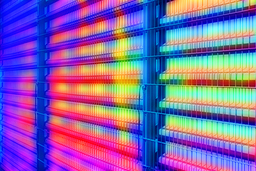Thin Multi-Layer Cell Structures for High-Performance Thermophotovoltaics
TECHNOLOGY NUMBER: 2018-355

OVERVIEW
Enhanced above-bandgap photon absorption and sub-bandgap photon reflection- Improved efficiency due to anti-reflective coatings, a black surface reflector, and spacer layers
- Thin films which facilitate use in mobile power generation, defense applications, and off-grid power generation
BACKGROUND
Thermophotovoltaic (TPV) energy conversion refers to a process during which thermal energy is converted to electrical energy. Compared to conventional photovoltaic solar panels, TPV panels have the potential for significantly higher energy densities and should be capable of providing comparable output power while using significantly smaller footprints. TPV devices consist of a thermal emitter and a photovoltaic structure tuned to infrared light. Upon absorption of heat, the thermal emitter radiates photons in the IR that are then absorbed by the photovoltaic that converts the emitted photons to electrical energy. For practical TPV devices to realize their theoretical efficiency and thus be economically viable, losses from the escape of photons from the thermal emitter to the environment need to be minimized. A need exists for new methods to meet these requirements.
INNOVATION
Researchers have invented a thermophotovoltaic cell design capable of theoretical efficiency as high as 52% with power outputs of 2.1 W/cm2, assuming a 1500K thermal source. The improved efficiency and power output from this technology is achieved by utilizing a combination of anti-reflective coatings to promote above-bandgap photon absorption, a back-surface reflector to promote sub-bandgap photon reflection back to the thermal source, and appropriate spacer layers. The optical properties of these designs have been tested and found to be in good agreement with theoretical simulations of the material. Importantly, the materials incorporated into these designs are all thin-films, which provides flexibility to the material, allowing its potential use in numerous applications including mobile power generation, defense applications, and off-grid power generation.